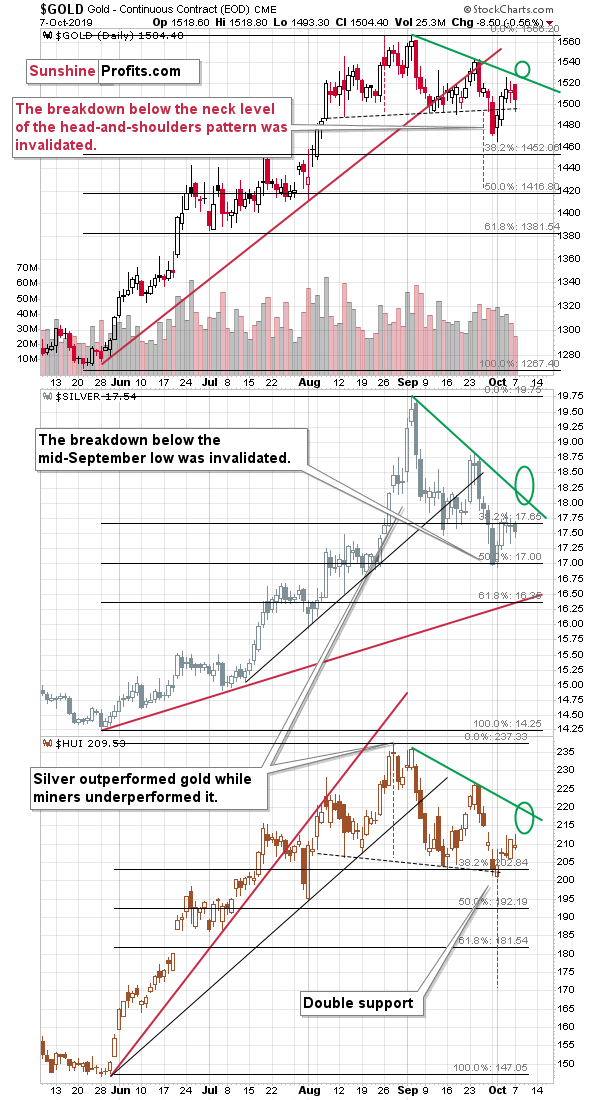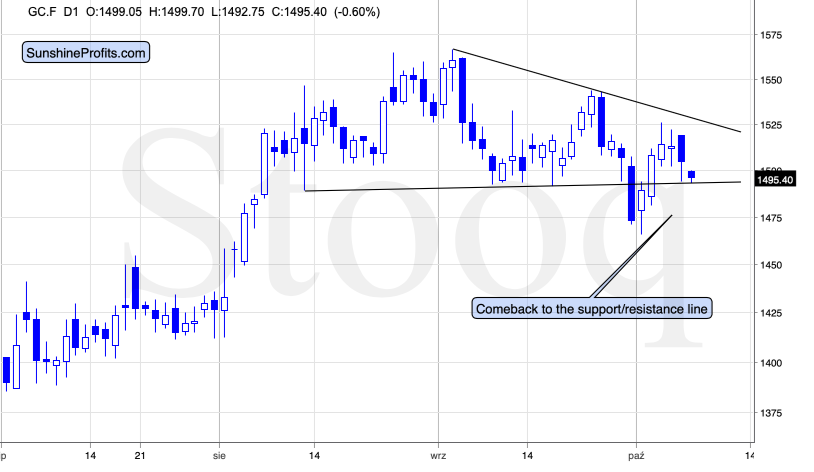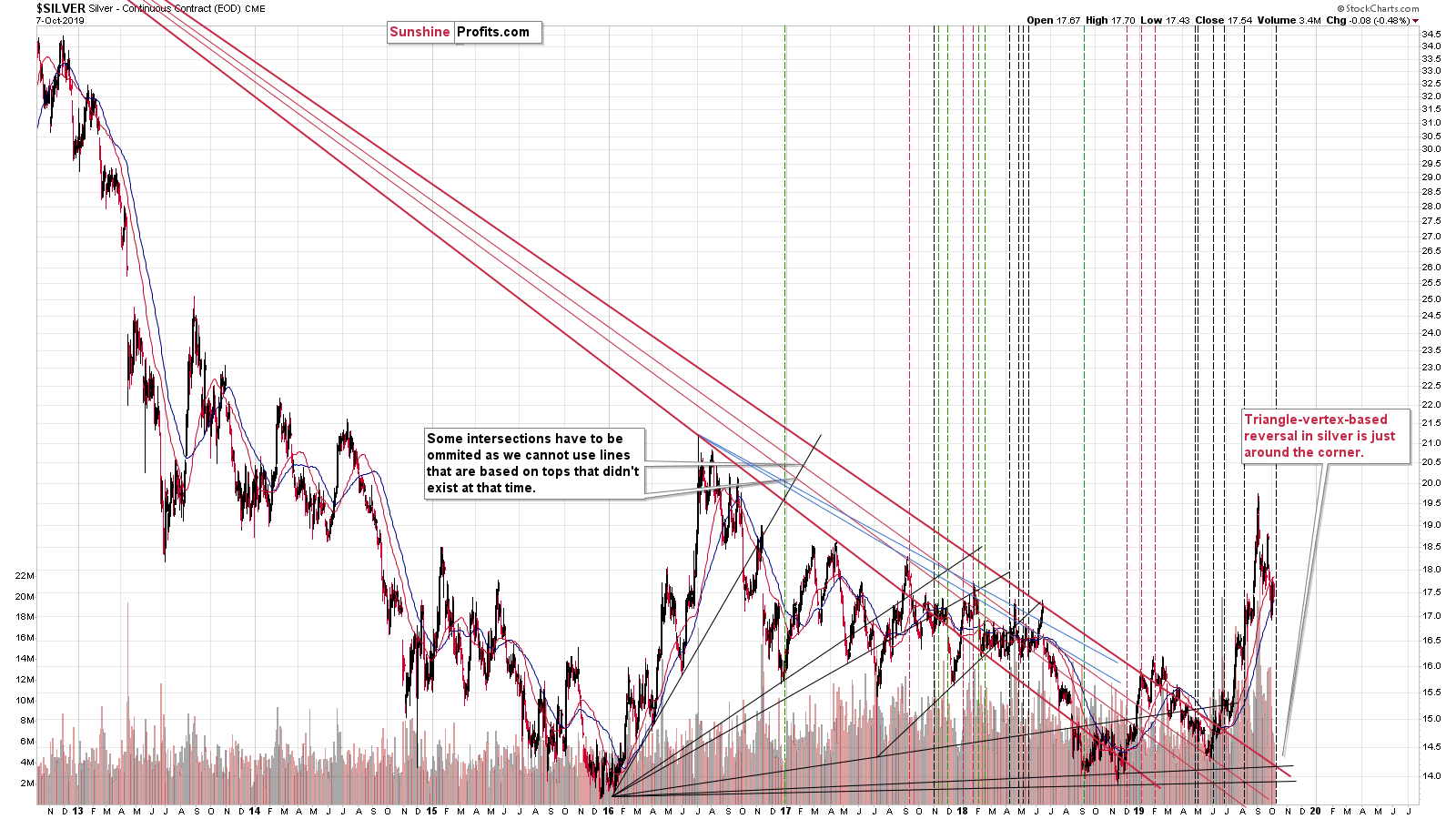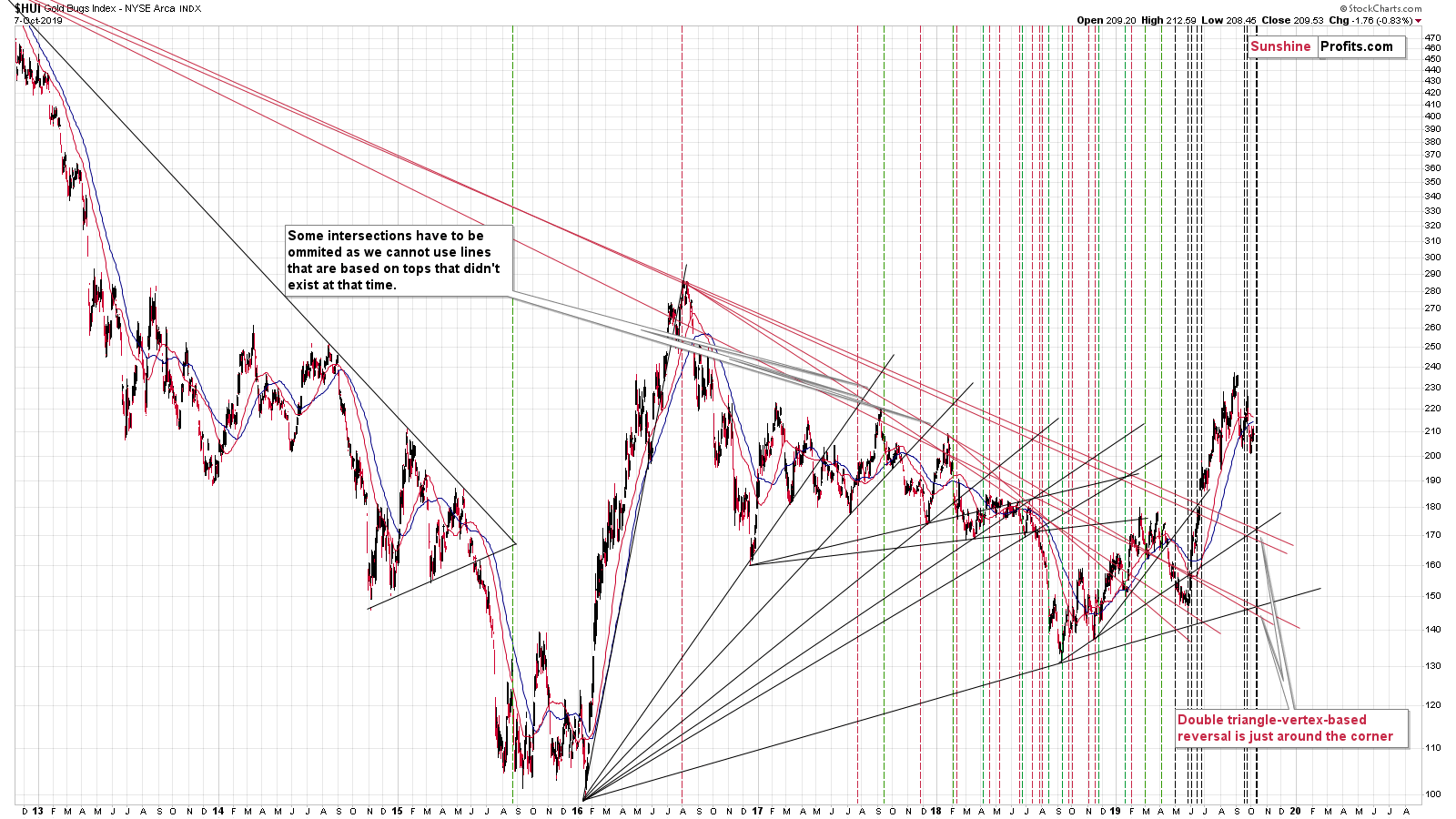Briefly: in our opinion, small (50% of the regular size of the position) speculative long position in gold, silver, and mining stocks are justified from the risk/reward point of view at the moment of publishing this Alert.
Gold has tested the area from which its late-September rally started, and is pointing higher in today's trading. Does it highlight that the recent miners' strength hasn't been a one-day phenomenon. But how much short-term strength can there still be in the metals?
Today's analysis is going to be relatively short as we don't have much to add to what we wrote yesterday and in the previous weeks. Yesterday's analysis remains up-to-date with regard to the very short-term outlook, and the Key Factors section that we have been quoting in the recent Alerts remains up-to-date with regard to the long- and medium-term outlook.
Let's take a look what happened in gold, silver, and mining stocks yesterday, and what is happening today.
The Short-Term in PMs
Gold, silver and mining stocks moved a bit lower yesterday, but the size of the movement was not identical. The important thing about this is that the decline in the mining stocks was smaller compared to the one in gold. It may not be obvious at first sight, as yesterday's move was not that significant, but it's clear when we compare the last two days together. Over the last two sessions, gold and silver declined, but mining stocks moved higher. That's not the first day the miners are showing strength, which increases the bullish implications for the short run.
Right now, gold is testing its yesterday's low and the neck level of the previous head-and-shoulders pattern that was invalidated. That's also the level from which - approximately - the late-September rally started.
Given the above, it seems more likely than it was previously that the next reversal in the precious metals market will be a local top and the triangle-vertex-based technique applied to the silver and HUI Index charts points to this or the next week as the likely time for the turnaround.
Timing the Reversals
The bullish outlook for the short term, the bearish outlook for the medium term and the nearby reversal confirm each other and together paint a quite coherent scenario for the following days and weeks.
Naturally, the key bearish factors for the medium term remain intact.
Key Factors to Keep in Mind
Critical factors:
- The USD Index broke above the very long-term resistance line and verified the breakout above it. Its huge upswing is already underway.
- The USD's long-term upswing is an extremely important and bearish factor for gold. There were only two similar cases in the past few decades, when USD Index was starting profound, long-term bull markets, and they were both accompanied by huge declines in gold and the rest of the precious metals market
- Out of these two similar cases, only one is very similar - the case when gold topped in February 1996. The similarity extends beyond gold's about a yearly delay in reaction to the USD's rally. Also the shape of gold price moves prior to the 1996 high and what we saw in the last couple of years is very similar, which confirm the analysis of the gold-USD link and the above-mentioned implications of USD Index's long-term breakout.
- The similarity between now and 1996 extends to silver and mining stocks - in other words, it goes beyond USD, gold-USD link, and gold itself. The white metal and its miners appear to be in a similar position as well, and the implications are particularly bearish for the miners. After their 1996 top, they erased more than 2/3rds of their prices.
- Many investors got excited by the gold-is-soaring theme in the last few months, but looking beyond the short-term moves, reveals that most of the precious metals sector didn't show substantial strength that would be really visible from the long-term perspective. Gold doesn't appear to be starting a new bull market here, but rather to be an exception from the rule.
- Gold's True Seasonality around the US Labor Day points to a big decline shortly.
Very important, but not as critical factors:
- Long-term technical signs for silver, i.a. the analogy in terms of price to what we saw in 2008, shows that silver could slide even below $10.
- Silver's very long-term cycles point to a major reversal taking place right now and since the most recent move was up, the implications are bearish (this is also silver's technical sign, but it's so important that it deserves its own point)
- Long-term technical signs for gold stocks point to this not being a new gold bull market beginning. Among others, it's their long-term underperformance relative to gold that hint this is rather a corrective upswing within a bear market that is not over yet.
- Record-breaking weekly volume in gold is a strong sign pointing to lower gold prices
Important factors:
- Extreme volume reading in the SIL ETF (proxy for silver stocks) is an effective indication that lower values of silver miners are to be expected
- Silver's short-term outperformance of gold, and gold stocks' short-term underperformance of gold both confirm that the precious metals sector is topping here
- Gold topped almost right at its cyclical turning point, which makes the trend reversal more likely
- Copper broke below its head-and-shoulders pattern and confirmed the breakdown. The last time we saw something similar was in April 2013, when the entire precious metals sector was on the verge of plunging lower.
Moreover, please note that while there may be a recession threat, it doesn't mean that gold has to rally immediately. Both: recession and gold's multi-year rally could be many months away - comparing what happened to bond yields in the 90s confirms that.
Copper moved above the neck level of its head-and-shoulders pattern that's based on the intraday lows, but it didn't invalidate the analogous level based on the weekly closing prices, so we don't think it's justified to say that this bearish formation was invalidated at this time.
Summary
Summing up, the big decline in the precious metals sector appears to be finally underway, but based on gold's invalidation of the breakdown below the head-and-shoulders pattern, a quick rally is more likely to take place in the very near term. Most likely, the rally will be short-lived and it will end this or the next week.
Once gold reaches $1,525, we think that it will be best (from the risk to reward point of view) to take profits off the table in case of the long positions in gold, silver, and mining stocks, and open the big short position in them that are in tune with the main trend. You will find details below.
In other news, we are temporarily (until the end of this week) providing you with access to our Oil & Forex Trading Alerts - until the end of the week you will also receive notifications whenever they are posted.
As always, we'll keep you - our subscribers - informed.
To summarize:
Trading capital (supplementary part of the portfolio; our opinion): Small speculative long position (50% of the full position) in gold, silver, and mining stocks is justified from the risk/reward perspective with the following stop-loss orders and binding exit profit-take price levels:
- Gold: profit-take exit price: $1,524.80; stop-loss: $1,488; initial target price for the UGLD ETN: $144.67; stop-loss for the UGLD ETN: $133.82
- Silver: profit-take exit price: $18.17; stop-loss: $17.16; initial target price for the USLV ETN: $98.96; stop-loss for the USLV ETN: $82.16
- Mining stocks (price levels for the GDX ETF): profit-take exit price: $28.58; stop-loss: $26.27; initial target price for the NUGT ETF: $33.77; stop-loss for the NUGT ETF $25.98
In case one wants to bet on junior mining stocks' prices, here are the stop-loss details and target prices:
- GDXJ ETF: profit-take exit price: $39.47; stop-loss: $35.48
- JNUG ETF: profit-take exit price: $71.48 stop-loss: $51.96
Important: even if gold is the only part of the precious metals market that reaches its upside target, all above-mentioned trades should be closed, and the trades below should be (in our opinion) opened:
Trading capital (supplementary part of the portfolio; our opinion): Once gold reaches $1,529, full speculative short position (250% of the full position) in gold, silver, and mining stocks will be justified from the risk/reward perspective with the following stop-loss orders and exit profit-take price levels:
- Gold: profit-take exit price: $1,391; stop-loss: $1,573; initial target price for the DGLD ETN: $36.37; stop-loss for the DGLD ETN: $25.44
- Silver: profit-take exit price: $16.41; stop-loss: $19.06; initial target price for the DSLV ETN: $20.96; stop-loss for the DSLV ETN: $14.07
- Mining stocks (price levels for the GDX ETF): profit-take exit price: $24.62; stop-loss: $30.11; initial target price for the DUST ETF: $10.32; stop-loss for the DUST ETF $6.08
In case one wants to bet on junior mining stocks' prices, here are the stop-loss details and target prices:
- GDXJ ETF: profit-take exit price: $33.82; stop-loss: $41.22
- JDST ETF: profit-take exit price: $21.58 stop-loss: $12.46
Long-term capital (core part of the portfolio; our opinion): No positions (in other words: cash)
Insurance capital (core part of the portfolio; our opinion): Full position
Whether you already subscribed or not, we encourage you to find out how to make the most of our alerts and read our replies to the most common alert-and-gold-trading-related-questions.
Please note that the in the trading section we describe the situation for the day that the alert is posted. In other words, it we are writing about a speculative position, it means that it is up-to-date on the day it was posted. We are also featuring the initial target prices, so that you can decide whether keeping a position on a given day is something that is in tune with your approach (some moves are too small for medium-term traders and some might appear too big for day-traders).
Plus, you might want to read why our stop-loss orders are usually relatively far from the current price.
Please note that a full position doesn't mean using all of the capital for a given trade. You will find details on our thoughts on gold portfolio structuring in the Key Insights section on our website.
As a reminder - "initial target price" means exactly that - an "initial" one, it's not a price level at which we suggest closing positions. If this becomes the case (like it did in the previous trade) we will refer to these levels as levels of exit orders (exactly as we've done previously). Stop-loss levels, however, are naturally not "initial", but something that, in our opinion, might be entered as an order.
Since it is impossible to synchronize target prices and stop-loss levels for all the ETFs and ETNs with the main markets that we provide these levels for (gold, silver and mining stocks - the GDX ETF), the stop-loss levels and target prices for other ETNs and ETF (among other: UGLD, DGLD, USLV, DSLV, NUGT, DUST, JNUG, JDST) are provided as supplementary, and not as "final". This means that if a stop-loss or a target level is reached for any of the "additional instruments" (DGLD for instance), but not for the "main instrument" (gold in this case), we will view positions in both gold and DGLD as still open and the stop-loss for DGLD would have to be moved lower. On the other hand, if gold moves to a stop-loss level but DGLD doesn't, then we will view both positions (in gold and DGLD) as closed. In other words, since it's not possible to be 100% certain that each related instrument moves to a given level when the underlying instrument does, we can't provide levels that would be binding. The levels that we do provide are our best estimate of the levels that will correspond to the levels in the underlying assets, but it will be the underlying assets that one will need to focus on regarding the signs pointing to closing a given position or keeping it open. We might adjust the levels in the "additional instruments" without adjusting the levels in the "main instruments", which will simply mean that we have improved our estimation of these levels, not that we changed our outlook on the markets. We are already working on a tool that would update these levels on a daily basis for the most popular ETFs, ETNs and individual mining stocks.
Our preferred ways to invest in and to trade gold along with the reasoning can be found in the how to buy gold section. Additionally, our preferred ETFs and ETNs can be found in our Gold & Silver ETF Ranking.
As a reminder, Gold & Silver Trading Alerts are posted before or on each trading day (we usually post them before the opening bell, but we don't promise doing that each day). If there's anything urgent, we will send you an additional small alert before posting the main one.
=====
Latest Free Trading Alerts:
If you look at the manufacturing data only, the relative strength of the jobs figures surprised. Another positive development were the upward revisions for August and July. The unemployment rate again dropped, this time to 3.5 percent. What will that mean for the Fed and gold?
Employment Data, Rate Cut Speculations and Gold
=====
Thank you.
Sincerely,
Przemyslaw Radomski, CFA
Editor-in-chief, Gold & Silver Fund Manager







